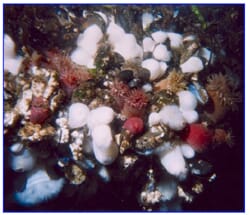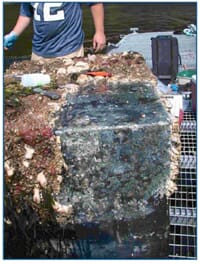The algae and invertebrates that colonize nets, walkway floats and anchor lines have rarely been studied in detail, yet it is an economically important problem to fish growers as they can foul the nets, reduce water flow through the pens and necessitate frequent cleaning and maintenance.
 |
| Collection of diverse invertebrates populating the undersides of a walkway float at the Deepwater Bay net-pens. |
This study shows that a typical floating fish pen system in Puget Sound is populated by a diverse group of over 100 species of seaweeds or invertebrates. These species provide a locally important component of the food web, providing enrichment for a variety of marine food web life including marine bird species. In this regard, the biofouling can be considered a beneficial effect of fish farming if we value diverse and richly populated marine food webs. The popular media-distributed notion of fish farming habitats often suggests a biological wasteland, heavily impacted by fish feces, waste feed, antibiotics and chemicals. Nothing could be further from the truth for Washington State fish farms (and those in the State of Maine). Antibiotics are rarely used (vaccines are used instead), no sea lice problems exist due to naturally reduced salinity levels, and farm siting involves locations with fast currents or relatively great depth that distribute wastes over large areas where they may be incorporated into the food web while maintaining aerobic surficial sea bottom sediments.
No Harmful Flora or Fauna
The flora and fauna of the subject net-pens did not include any harmful, invasive exotic species (e.g. exotic tunicates) and was not similar to that seen on floats and pilings in degraded, marina environments in urbanized bays and marinas. Rather they included a diverse assemblage of species, many of which could be considered important prey items in the food web. This result should not be surprising, as net]pen siting and operational practices in the Pacific Northwest have evolved greatly from their beginnings over 30 years ago from backwater locations to fast flushing, nutrient replete channels with good water quality.
Fish containment nets provided over 18,000 m2 of submersed surface area (one side only), far exceeding the submerged area of anchor lines and walkway floats. Approximately 360,000 individual invertebrates were collected, identified, enumerated, weighed and recorded on these surface areas. Thousands of seaweed samples were collected too. At least 100 species were identified and the total number of species probably far exceeds that number as some major groups like polychaete worms were lumped into major groups only due to the sheer volume of samples.
About 1/3 of the species diversity was represented by seaweed or algae, the other 2/3 were invertebrates and three species of fish.
Biofouling
 |
| Removal of cage float for sampling by Bill Clark, AGS Inc. Deepwater Bay site manager. |
The quantity of biofouling existing on the submerged surfaces during summer was measured to be approximately 55 metric tons (wet weight, 95 per cent confidence interval of 45.6 to 65.5 MT). This is a large amount of biological material in a small area, but represents only about 5 per cent of the peak farmed fish biomass held at one time during the study period.
The single most important substrate was anchor lines (23.8 MT) due principally to the presence of an ecologically desirable species of seaweed known as bull kelp (Nereocystis luetkeana about 2/3 of the wet weight of all colonizing species) but also to the fact that anchor lines are a stable habitat for many years before they are routinely replaced, allowing a climax community of kelp, tube worms and other species to become well established. This was a surprising result because the submerged surface area of anchor lines was only 0.6 per cent of the total, the bulk of it was nets (90.5 per cent) and walkway floats (8.9 per cent). Walkway floats and fish containment nets had equal biovolume of invertebrates and algae (15.9 MT each) during summer but very different species compositions. Barnacles were not numerically dominant but because of their heavy shells were important by volume. Mussels (Mytilus), the seaweed Costaria costata (five rib kelp) and sea anemones (Metridium senile) and ribbon kelp (Alaria marginata) were 2nd through 5th important for wet weight biomass, respectively on walkway floats. Biocolonization on nets was dominated in spring by massive abundance of pinktop hydroids (Ectopleura marina), mussels and amphipods but shifted to caprellid shrimp, filamentous diatoms/algae and amphipods in both summer and winter. The biofouling was on nets that were periodically cleaned, sampling sites were selected randomly. The quantities of caprellid shrimp and amphipods on the netting was incredibly large (several hundred thousand per m2) which made sample sorting and enumeration very difficult. Special techniques were developed to deal with these challenges.
In addition to a diverse assemblage of organisms, some of the most abundant were also commercially important species or potentially important. Mussels (Mytilus edulis) were common on floats, nets and lines despite intense predation by sea ducks (surf scooters) during the fall through spring period. A seaweed of potential commercial value, Alaria marginata (ribbon kelp), was the second most dominant contributor to biomass on anchor lines during summer, after bull kelp.
Seaweed and Mussels
 |
| Sampling by scraping biocolonization from different surfaces of a net pen float. |
Seaweed and mussels are being grown in other regions to sequester wastes from net-pens as a means of mitigation known as Integrated Multitrophic Aquaculture (IMTA) or simply Integrated Aquaculture. Such a technique may be of benefit for some sites in the Pacific Northwest too, although most sites in Puget Sound have strong currents and all sites are in non-nutrient sensitive areas so there is no existing problem with nutrients or solids assimilation into the food web. It is possible to position mussel rafts or kelp]growing lines downstream of some net pens without compromising water flow rates that maintain oxygen concentrations or strong subsurface waste resuspension rates.
Naturally occurring stable isotopes of nitrogen and carbon were measured in several key biocolonization species at the farm site and at a reference area. Enrichment of the ratio of 15N to 14N isotope form of the nitrogen at the net pen site is the basis for the measurements. These data indicate a direct positive transfer of fish farm nitrogen to several key organism including amphipods, caprellid shrimp and mussels on nets and floats. A positive effect was also measured for carbon isotope transfer to mussels. Metridium senile (common plumose anemone) results did not indicate a stable isotope signal; they may not benefit as local research has shown they feed exclusively on pelagic zooplankton. The farm walkway floats provide habitat for them, but apparently not feed.
Other species remain to be investigated regarding their stable isotope signature including bull kelp.
By further sampling of feed and fish feces it may be possible to quantify the degree to which each key biocolonization species is benefiting from farm wastes through application of a standard mixing model. Other studies could include assaying the effects on small fishes that sometimes reside downstream of the farms or on sea ducks who obviously are attracted to the farms and nearby enriched habitat. This study is only one contribution to the beginning of our understanding of the extent of food web enhancement that likely exist at most properly sited and operated fish farms.
Further Reading
| - | You can view the full report by clicking here. |

